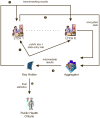Secure surveillance of antimicrobial resistant organism colonization or infection in Ontario long term care homes
- PMID: 24714643
- PMCID: PMC3979675
- DOI: 10.1371/journal.pone.0093285
Secure surveillance of antimicrobial resistant organism colonization or infection in Ontario long term care homes
Abstract
Background: There is stigma attached to the identification of residents carrying antimicrobial resistant organisms (ARO) in long term care homes, yet there is a need to collect data about their prevalence for public health surveillance and intervention purposes.
Objective: We conducted a point prevalence study to assess ARO rates in long term care homes in Ontario using a secure data collection system.
Methods: All long term care homes in the province were asked to provide colonization or infection counts for methicillin-resistant Staphylococcus aureus (MRSA), vancomycin-resistant enterococci (VRE), and extended-spectrum beta-lactamase (ESBL) as recorded in their electronic medical records, and the number of current residents. Data was collected online during the October-November 2011 period using a Paillier cryptosystem that allows computation on encrypted data.
Results: A provably secure data collection system was implemented. Overall, 82% of the homes in the province responded. MRSA was the most frequent ARO identified at 3 cases per 100 residents, followed by ESBL at 0.83 per 100 residents, and VRE at 0.56 per 100 residents. The microbiological findings and their distribution were consistent with available provincial laboratory data reporting test results for AROs in hospitals.
Conclusions: We describe an ARO point prevalence study which demonstrated the feasibility of collecting data from long term care homes securely across the province and providing strong privacy and confidentiality assurances, while obtaining high response rates.
Conflict of interest statement
Figures
References
-
- Thurn JR, Belongia EA, Crossley K (1991) Methicillin-resistant Staphylococcus aureus in Minnesota nursing homes. J Am Geriatr Soc 39: 1105–1109. - PubMed
MeSH terms
LinkOut - more resources
Full Text Sources
Other Literature Sources
Medical


